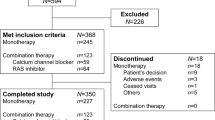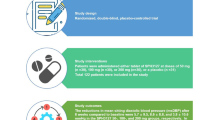Abstract
Objective: This study compares the antihypertensive efficacy and tolerability of valsartan, a novel angiotensin II antagonist, given with hydrochlorothiazide (HCTZ) vs placebo or vs valsartan or HCTZ alone.
Design: 871 adult out-patients with essential hypertension participated in this double-blind study. Patients were randomised in equal number to receive either combination therapy of valsartan (80 mg or 160 mg) and HCTZ (12.5 mg or 25 mg), or valsartan (80 mg or 160 mg) or HCTZ (12.5 mg or 25 mg) alone, or placebo. Patients were treated once daily for 8 weeks and assessed at 2, 4 and 8 weeks after randomisation.
Main outcome measures: The primary efficacy variable was change from baseline in mean sitting diastolic blood pressure (MSDBP) at end-point. The secondary variable was change in mean sitting systolic blood pressure (MSSBP) from baseline to end-point.
Results: All active treatments produced a statistically significant difference in MSDBP (P < 0.001) from baseline to end-point compared with placebo. similar results were obtained for mssbp. all combination regimens produced a statistically significantly greater reduction in msdpb and mssbp than the corresponding monotherapies. dizziness and headache were the most common treatment-related adverse experiences reported. hypokalaemia, associated with the use of thiazide diuretics, was more commonly reported in the higher dose hctz 25 mg groups.
Conclusions: Valsartan 80 mg and 160 mg act additively with HCTZ 12.5 mg or 25 mg to lower MSDBP and MSSBP in patients with essential hypertension. The addition of HCTZ to valsartan 80 mg or 160 mg was well tolerated.
This is a preview of subscription content, access via your institution
Access options
Subscribe to this journal
Receive 12 digital issues and online access to articles
$119.00 per year
only $9.92 per issue
Buy this article
- Purchase on Springer Link
- Instant access to full article PDF
Prices may be subject to local taxes which are calculated during checkout
Similar content being viewed by others
Author information
Authors and Affiliations
Additional information
Sponsorship: This study was sponsored by Novartis
Rights and permissions
About this article
Cite this article
Benz, J., Black, H., Graff, A. et al. Valsartan and hydrochlorothiazide in patients with essential hypertension. A multiple dose, double-blind, placebo controlled trial comparing combination therapy with monotherapy. J Hum Hypertens 12, 861–866 (1998). https://doi.org/10.1038/sj.jhh.1000718
Received:
Accepted:
Published:
Issue Date:
DOI: https://doi.org/10.1038/sj.jhh.1000718



